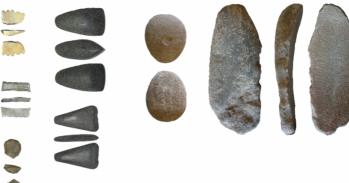
The most historically significant collection of Fijian objects in the world outside of Fiji will go on display from today (June 7) at Cambridge University’s Museum of Archaeology and Anthropology (MAA).
The most historically significant collection of Fijian objects in the world outside of Fiji will go on display from today (June 7) at Cambridge University’s Museum of Archaeology and Anthropology (MAA).
These exquisite objects have many stories to tell, and throughout the exhibition we are trying to explore the power of Fijian art in the past and present.
Anita Herle
Chiefs and Governors: Art and Power in Fiji is the first major exhibition of Fijian art in the UK, and will be on display in MAA’s Li Ka Shing Gallery from June 7, 2013 to April 2014.
It will showcase MAA’s considerable Fijian collection which includes whale ivory ornaments, wooden figures, and richly patterned barkcloths (masi). The astonishing range of material is a testament to the creativity and expertise of its makers, and some of the objects on display rank among the greatest masterpieces of Polynesian art.
The exhibition gets its name from, and primarily tells the story of, the relationship between Fijian Chiefs and British Governors in the late 19th century. Many of the objects on display were given as gifts and are highly-valued objects which figured prominently in Fijian social life.
Finely crafted items, such as whale ivory breastplates and neck ornaments also show us how specialist knowledge and skills moved in Western Polynesia from the late 18th century. Materials originating from the sea such as whale’s teeth carried high status and were exchanged between competing chiefs or to mark births, deaths, and the settlement of grievances.
This collection is particularly special to the museum as it formed the core of MAA’s founding ethnological collections when it first opened in 1884. The museum’s first curator Baron Anatole von Hügel convinced the Governor of Fiji, Sir Arthur Hamilton-Gordon, to donate Fijian material collected by government officials and guests to the University in 1883.
One of the central displays in the exhibition is a large symmetric arrangement of wooden clubs and paddles. It was recreated from a photo from 1875 of the back wall of the dining room at Government House, the seat of British government in Fiji. The display was a special blend of Victorian and local aesthetics of the time, using weapons to signal status as well as to create artistic patterns.
Dr Anita Herle, co-curator of the exhibition and senior curator for anthropology at MAA, said: “These exquisite objects have many stories to tell, and throughout the exhibition we are trying to explore the power of Fijian art in the past and present.
“The exhibition is part of a collaborative three-year research project called the Fijian Art Research Project, which aims to catalogue and learn more about the collections of Fijian Art held in museums around the world.”
The opening of Chiefs and Governors marks the centenary of MAA in its current purpose-built museum building on Downing Street.
Chiefs & Governors is one of the outcomes of the AHRC-funded Fijian Art research project (2011-14), a collaborative project with numerous museum partners, including the Fiji Museum, and the Sainsbury Research Unit at the University of East Anglia.
For more information please visit the Facebook page https://www.facebook.com/fijianartproject, and the project website www.fijianart.sru.uea.ac.uk
This work is licensed under a Creative Commons Licence. If you use this content on your site please link back to this page.





